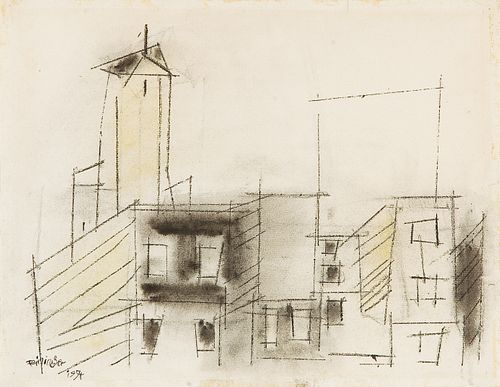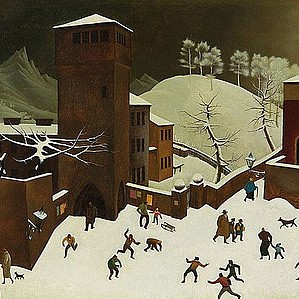LYONEL FEININGER (New York 1871 - 1956 New York) City with Church Tower, 1954
Lot 156
Categories
Estimate:
EUR€8,000 - EUR€16,000
$8,602.15 - $17,204.30
Absentee vs Live bid
Two ways to bid:
- Leave a max absentee bid and the platform will bid on your behalf up to your maximum bid during the live auction.
- Bid live during the auction and your bids will be submitted real-time to the auctioneer.
Bid Increments
| Price | Bid Increment |
|---|---|
| EUR€0 | EUR€10 |
| EUR€100 | EUR€50 |
| EUR€700 | EUR€100 |
| EUR€1,000 | EUR€200 |
| EUR€3,000 | EUR€300 |
| EUR€3,600 | EUR€400 |
| EUR€4,000 | EUR€500 |
| EUR€7,000 | EUR€1,000 |
| EUR€16,000 | EUR€2,000 |
| EUR€30,000 | EUR€3,000 |
| EUR€36,000 | EUR€4,000 |
| EUR€40,000 | EUR€5,000 |
About Auction
By Widder Auctions
May 19, 2022
Set Reminder
2022-05-19 11:00:00
2022-05-19 11:00:00
America/New_York
Bidsquare
Bidsquare : Masterpieces
https://www.bidsquare.com/auctions/widder-auctions/masterpieces-9287
Masterpieces of classical modernism by Austrian and international artists coming up for auction in Vienna on May 19th Widder Auctions office@widderauktionen.com
Masterpieces of classical modernism by Austrian and international artists coming up for auction in Vienna on May 19th Widder Auctions office@widderauktionen.com
- Lot Description
LYONEL FEININGER*
(New York 1871 - 1956 New York)
City with Church Tower, 1954
indian ink and chalk/paper, 22,4 x 29 cm
signed Feininger and dated 1954
the work was authenticated by Achim Moeller, head of the Lyonel Feininger project, and registered with the number 1668-08-31-20 and included in the cat. raisonné
Provenance: Peter Kamnitzer USA, private collection, Sothebys London 2021, private collection
ESTIMATE °€ 8.000 - 16.000
German-American painter, graphic artist, caricaturist and composer of the 20th century. Main representative of Classical Modernism, especially German Expressionism. Born in New York as a child of German immigrants, he came to Germany to study. From 1909 member of the Berlin Secession. 1911 in Paris impulses from Robert Delaunay and French Cubism. 1912 to the artists of the Blue Rider and beginning of friendship with Alfred Kubin. 1918 Member of the November Group around Max Pechstein and acquaintance with Walter Gropius, who brought him to the Bauhaus in Weimar and later to Dessau and Berlin. Together with Paul Klee, Wassily Kandinsky and Alexej Jawlensky founded the artist group Die blaue Vier. In 1937 his works were classified by the Nazis as degenerate art. 1937 Emigration to the USA, lived in New York. Contact with Fernand Léger and Marsden Hartley. Created mainly graphic works but also oil paintings with architecture, ships and locomotives.
For the German-American artist and important Bauhaus teacher Lyonel Feininger, who was born in New York in 1871, cityscapes held a special fascination throughout his life. This was also reflected in his artistic oeuvre: Subjects with houses and church spires not only take up a lot of space, but also represent a constant in his work, conceived as abstract, light-flooded color surfaces. He usually made “notes” first, as he called his sketches, on site. He saw these as his “artistic capital” and then used them repeatedly in his later paintings, drawings and prints as inspiration for cubist-inspired works in his unmistakable linear-geometric style. From these he should then - similar to the romantic painters - only develop his abstract views in the studio and thus very far from the depicted landscapes. As early as 1907 he legitimized this way of working: “What is seen must be internally reshaped and crystallized.” In the present ink drawing, which is dated 1954 and can therefore be regarded as a late work by the then eighty-three-year-old artist, he sticks to the crystalline structure and ostentatious mood true to his mature style. He is still full of energy, as he wrote to Tekla Hess in a letter dated July 15, 1951: “I am now becoming aware of the importance of approaching 80, although this seems like an overestimated decade. I feel fresh (...) and full of ideas and not as old as I imagine. In any case, I expect to continue working, and that for quite a while.” Feininger develops this cubist-abstract landscape again with those fine ink lines, which, like tailors’ patterns, always seem slightly interrupted and remind us of his alley studies in Neu Brandenburg from 1925. In this way Feininger achieves the greatest possible abstraction, dematerialization and transparency. Feininger's friend, the art historian Alois J. Schardt, wrote in 1921 that constant reassurance about natural phenomena saved Feininger from a formulaic paralysis that threatened completely abstract art.
PLEASE NOTE:
The purchase price consists of the highest bid plus the buyer's premium, sales tax and, if applicable, the fee of artists resale rights. In the case of normal taxation (marked ° in the catalog), a premium of 24% is added to the highest bid. The mandatory sales tax of 13% is added to the sum of the highest bid and the buyer's premium. The buyer's premium amounts to 28% in case of differential taxation. The sales tax is included in the differential taxation. - Shipping Info
-
Shipping
We will send you the invoice shortly after the auction. As soon as we have recieved the amount, the art can be picked up at Johannesgasse 9-13, 1010 Vienna. Please note that the buyer is responsible for pick-up and shipping of the lot.
Should you wish to ship your items, please contact: Mailboxes Email: oper@mbe-co.at Tel: 01 5128855
Please note that storage fees may apply, should the pieces not be picked up within 14 days after invoicing for domestic and 28 days for international transportation.
Our team will be happy to assist you with any further information at office@widderauktionen.com or at 0043 676 555 66 10.
-
- Buyer's Premium



 EUR
EUR CAD
CAD AUD
AUD GBP
GBP MXN
MXN HKD
HKD CNY
CNY MYR
MYR SEK
SEK SGD
SGD CHF
CHF THB
THB













